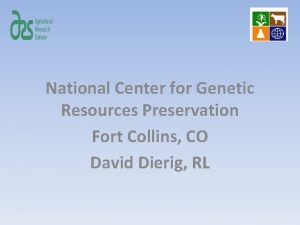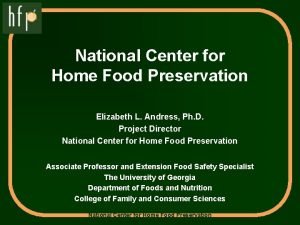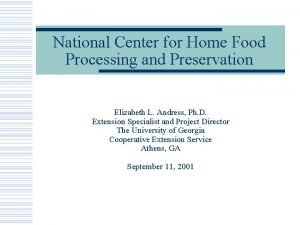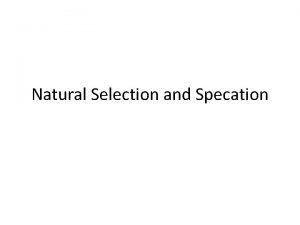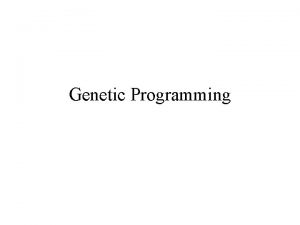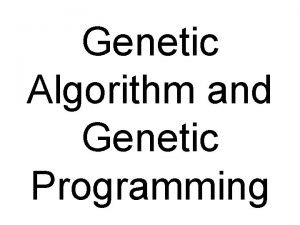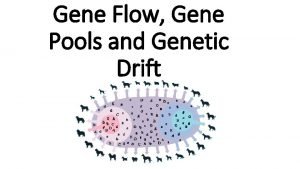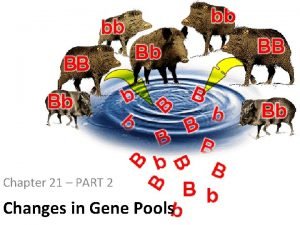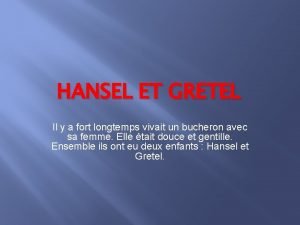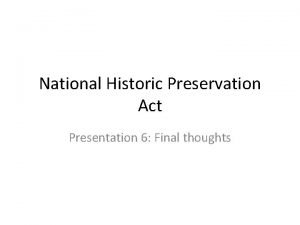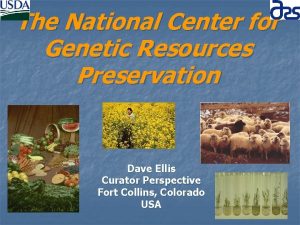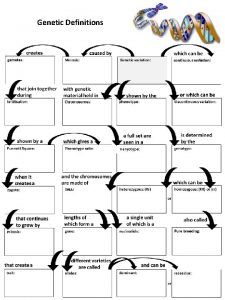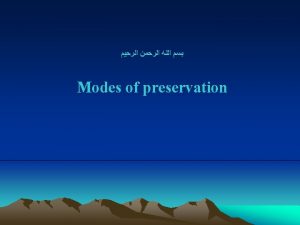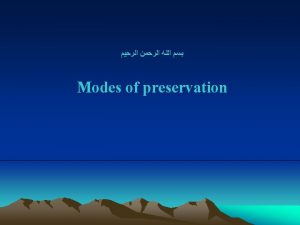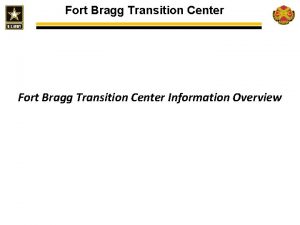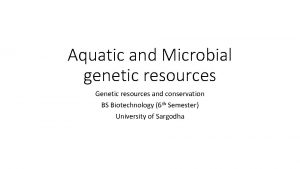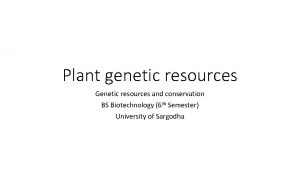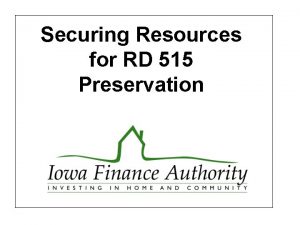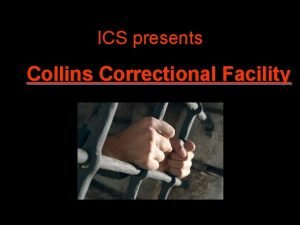National Center for Genetic Resources Preservation Fort Collins











- Slides: 11

National Center for Genetic Resources Preservation Fort Collins, CO David Dierig, RL

• Research at NCGRP

Non-invasive assays of Seed Longevity and Seed Aging Christina Walters and Dani Ballesteros 25 o. C Problem: We cannot tell how long a seed will survive during storage, nor how much it has aged, until we germinate it. Germination assays -18 o. C Maize inbred (Pioneer) #1, stored 20 yrs • consume seed • are costly • only describe health at the moment • have no predictive power • give categorical (not quantitative) information Non-invasive assays are quantitative and predictive Dynamic Mechanical Analysis Differential Scanning Calorimetry 6 mm Structural stability correlates with longevity Lipid crystallization decreases with aging Volatile Analysis using Gas Chromatography Volatiles production correlates with longevity

Citrus Cryopreservation Gayle Volk Concern: Loss of key collection materials due to Huanglongbing disease Response: Develop strategy to cryopreserve vegetative propagules of Citrus accessions • Receive non-dormant bud material from Riverside • Excise 1 mm shoot tips • Cryopreserve using vitrification • Recovery by micrografting onto seedling rootstock in tissue culture Grafted, cryopreserved Citrus shoot tips 13 days after micrografting Customer response: Invitations by Citrus Research Board to present at meetings and to submit proposal for industry funding

How do we efficiently capture genetic diversity in wild populations? N. American Hops Chris Richards With NCGR Corvallis, OR Germplasm from wild populations is difficult to preserve because it is heterogeneous, not adapted to storage, and difficult to regenerate. Representative collections, without duplication, require targeting the diversity “hot spots” or genetic lineages. We developed analytical methods to estimating adaptive differentiation by integrating • Population genetic variation (SNP, SSR) • Ecological data • Spatial niche modeling analysis Little Sunflower With NCRPIS Ames, IA

How do traits like seed dormancy or afterripening affect genetic diversity? Von Mark Cruz and David Dierig Traits like after-ripening serve plant populations well in times of extreme environmental conditions to ensure survival but gene flow between plant classes may limit preservation of desired diversity. Sympatric population of two Lesquerella species in NM Collections with Gabriella Romano – Parlier, CA Two plants of the same species at different growth and reproductive maturity stages due to dormancy. Methods: Phenotypic field measurements and seed collections Germination time for plant classes and temperature plus water stress response Molecular markers to measure diversity Characterization of genes related to seed dormancy

Re-cryoprocessed potato PVP accessions prior to 2004 Maria Jenderek • Objective: Improve quality of potato accessions in cryopreservation • Problem: Previous protocols lead to low viability after storage in cryo. • A new protocol was adapted, and 54 accessions are being reprocessed, thus improving the viability to>50% • Impact: • After PVP expires, the potato cultivars will be integrated into the public domain (NPGS) • The NCGRP is to be reimbursed $2, 400/accession for this service • The value of the U. S. potato industry is >$3 billion

Personnel Issues Retired tech position filled in FY 10 for micrografting, tissue culture with Gayle Volk New Position is planned to coincide with retirement of Judy Grotenhuis to start in August (Renee White) New part-time molecular genetics tech Position is being planned with Chris Richards Post doc started in March with Dave Dierig New HQ post doc to start in Aug with Gayle Volk

Funded SCAs and CRADAs CSU, CO Seed Lab, $20, 000 – Evaluation of seed Longevity of Germplasm Placed in Long Term Storage. Exp. 2010 (plans to renew if possible) CIMMYT, $38, 600 -0 Aid in the Conservation and Regeneration of Maize and Maize Relatives in Mexico. Exp. 2012 (will not fund if no budget increase)

Other Extramural Funds • New SCA with CSU being developed to collaborate on the Citrus/ Avocado project using HQ funds.

Facility Issues • We have worked with NREL, Climate. Wise, and Lawrence Berkeley Labs on energy audits to reduce utility costs for the facility. • Roof leaks and age indicate a new roof is needed. We hope to do phase 1 in FY 11. • -18 vault has ice build up issues we’re looking into solutions. • Phones work on good days.
 National center for genetic resources preservation
National center for genetic resources preservation National food preservation
National food preservation National center for home preservation
National center for home preservation Fort collins flood 1997
Fort collins flood 1997 Genetic drift definition
Genetic drift definition Genetic programming vs genetic algorithm
Genetic programming vs genetic algorithm Genetic programming vs genetic algorithm
Genetic programming vs genetic algorithm What is gene flow and genetic drift
What is gene flow and genetic drift Gene flow vs genetic drift
Gene flow vs genetic drift Chant je suis fort fort oui plus que vainqueur
Chant je suis fort fort oui plus que vainqueur Il y a fort fort longtemps
Il y a fort fort longtemps National historic preservation act
National historic preservation act
